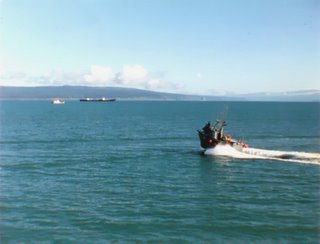B.B. Regional Seafood Development Association News

This is just one of the 12 "Regionals" that have been allowed by state statute and one of the three that have been approved to date. One benefit that might not have been in anyone's thinking when someone the divided up the State like this was that the best business plan could be followed by the others.
Bristol Bay gillnet boats are getting pretty high tech these days.
And that there might be some effort by one or more Regional to purposely pave the way for the rest. And that the smaller ones that obviously won't be able to generate enough money to operate could piggy-back on a large one, but they would have to organize.
The Assessment Vote by Bristol Bay fishermen will be on May 1, 2006. There is going to be a permit holders meeting in Anchorage to explain details on February 27, 2006 at the Diamond Center Hotel in Anchorage.
BB-RSDA Bristol Bay Regional Seafood Development Association
Overview ;
Bristol Bay salmon account for roughly 1/3 of the total value of all Alaska salmon. It is the single most valuable salmon fishery in Alaska. Ex-vessel value for Bay sockeye is lower than sockeye harvested in most other Alaska regions - and the gap is growing wider. Despite this, no broad-based organization currently promotes Bristol Bay seafood, works to improve quality or addresses infrastructure needs - all of which will help improve ex-vessel prices.
Now Bristol Bay permit holders can help change this. Recently passed state law authorizes the establishment of Regional Seafood Development Associations (RDSA's). Under this new law, an RSDA may market and promote the region's seafood, seek improvements to the area's infrastructure, work to raise quality. An RSDA may also conduct market research, education and product development.
RSDA's are organized and managed by permit holders. In June 2005, a group of Bristol Bay drift net fishermen filed an application to establish a RSDA for the Bristol Bay region. The state of Alaska approved that application and an official RSDA now exists for the Bay. The next step is to fund the new group.To fund the RSDA, permit holders must vote to approve an assessment on their harvests. Thirty percent of the permit holders in each gear group must vote and a majority of those voting must approve the assessment.
Each area gear group votes separately on self-assessment. Assessment revenues are collected by the State of Alaska and then appropriated to the RSDA. Bristol Bay drift net fishers will be asked to vote by May 1, 2006 to approve a 1% assessment on their harvest - the same amount that had been collected to help support ASMI. Setnet fishers are expected to join the RSDA and conduct a similar election. If approved, an estimated $850,000 - $1,000,000 go to improving values of Bristol Bay seafood, mainly sockeye. That amount will make a difference - it is roughly ASMI's annual promotional budget for all of Alaska's sockeye.
A board elected by permit holders will control the BB-RSDA. That elected board determines policies, priorities and specific programs. Seats on the elected board will reflect the proportionate assessments paid by each gear group. Currently an interim board is volunteering to help with the initial organization of the BB-RSDA.
Fishermen control over the RSDA is further strengthened by an "un-do" provision in Alaska RSDA law for terminating the RSDA assessment. Alaska statutes (Sec 43.76.375) creating the RSDA also include a provision allowing permit holders to end the 1% assessment. A petition signed by 10% of the permit holders triggers a mandatory election to determine whether the assessment should terminate.
Bristol Bay fishermen can expand their participation in the conduct of their fishery. Doing so may result in higher fish values by improving quality and market demand. Approving the assessment is the best way to change the status quo by promoting our products, expanding our markets and raising the value of our sockeye. The BB-RSDA is a solid investment in the future of our fishery.


<< Home